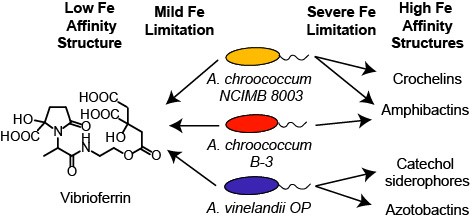In a recent Metallomics article (Metallomics Emerging Investigators special issue), we report the evolution of bacterial low and high-affinity siderophore families and their production patterns in Azotobacter sp., common plant growth promoting soil diazotrophs. The results highlight the importance of a conserved low-affinity siderophore structure alongside an arsenal of variable high-affinity siderophore structural families. These insights are relevant to understand why many bacteria are able to produce multiple siderophore structures and how beneficial siderophore producers affect the growth of plants and other rhizosphere microbes.

Zhang, X. *, O. Baars *, F. M. M. Morel, Genetic, structural, and functional diversity of low- and high-affinity siderophores in strains of nitrogen fixing Azotobacter chroococcum, Metallomics, DOI: 10.1039/c8mt00236c
(*authors contributed equally) <pdf>
